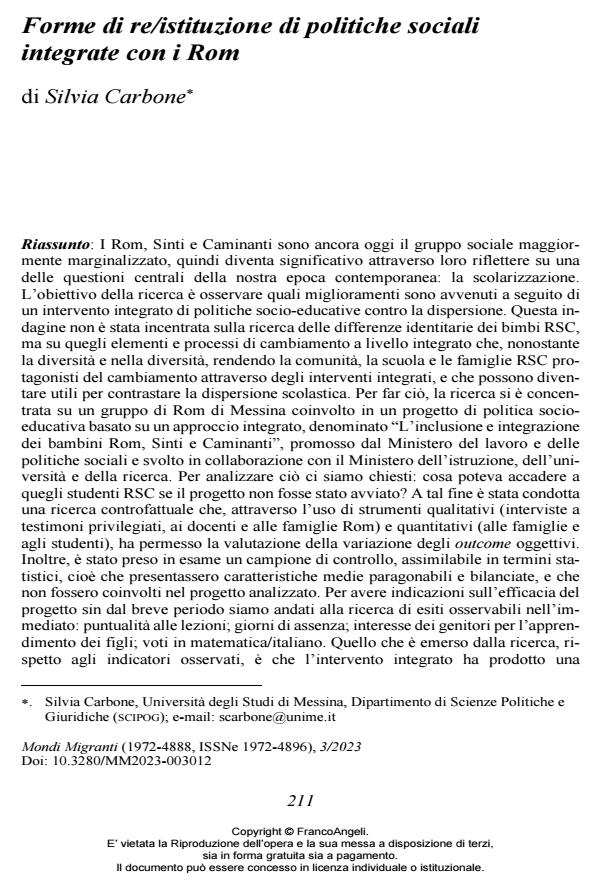Forms of re/institution of social policies integrated with the Roma
Journal title MONDI MIGRANTI
Author/s Silvia Carbone
Publishing Year 2023 Issue 2023/3
Language Italian Pages 22 P. 211-232 File size 231 KB
DOI 10.3280/MM2023-003012
DOI is like a bar code for intellectual property: to have more infomation
click here
Below, you can see the article first page
If you want to buy this article in PDF format, you can do it, following the instructions to buy download credits

FrancoAngeli is member of Publishers International Linking Association, Inc (PILA), a not-for-profit association which run the CrossRef service enabling links to and from online scholarly content.
Roma, Sinti and Caminanti can still be considered the most marginalized social group, so it becomes significant through them to reflect on one of the central issues of our contemporary times: schooling. The objective of this research is to observe what improvements have occurred as a result of an integrated so-cio-educational policy intervention against early schooling. This investigation was not focused on researching the identity differences of RSC children, but on those elements and processes of change at the integrated level that, despite diversity and in diversity, by making the community, school and RSC families protagonists of change through integrated interventions, can become useful in countering school dropout. To do this, the research focused on a group of Ro-ma in Messina involved in a socio-educational policy project based on an in-tegrated approach, called “The Inclusion and Integration of Roma, Sinti and Caminanti Children”, promoted by the Ministry of Labor and Social Policy and carried out in collaboration with the Ministry of Education, University and Re-search. To analyze this, we asked ourselves: what could have happened to those RSC students if the project had not been initiated? To this end, counter-factual research was conducted that, through the use of qualitative (interviews with teachers and RSC families) and quantitative (with families and students) instruments, allowed for the assessment of variation in objective outcomes. In addition, a control sample was examined, assimilated in statistical terms, that is, having comparable and balanced average characteristics, and not involved in the project analyzed. To get indications of the project's effectiveness from the short term, we went looking for observable outcomes in the immediate term: punctuality to classes; days of absence; parental interest in their chil-dren's learning; grades in math/Italian. What emerged from the research, with respect to the observed indicators, is that the integrated intervention produced a change in the expected direction that was large and statistically significant. If we look at the control group, we notice that there is a generalized worsening trend over time for the indicators of interest. For the treatment group, the inte-grated intervention halted or even reversed this trend causing the significant improvement in relative terms.
Keywords: Roma; integrated social policies; educational poverty; dispersion; community.
Silvia Carbone, Forme di re/istituzione di politiche sociali integrate con i Rom in "MONDI MIGRANTI" 3/2023, pp 211-232, DOI: 10.3280/MM2023-003012